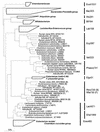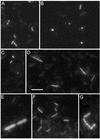Extensive set of 16S rRNA-based probes for detection of bacteria in human feces
- PMID: 12039758
- PMCID: PMC123985
- DOI: 10.1128/AEM.68.6.2982-2990.2002
Extensive set of 16S rRNA-based probes for detection of bacteria in human feces
Abstract
For the detection of six groups of anaerobic bacteria in human feces, we designed seven new 16S rRNA-based oligonucleotide probes. This set of probes extends the current set of probes and gives more data on the composition of the human gut flora. Probes were designed for Phascolarctobacterium and relatives (Phasco741), Veillonella (Veil223), Eubacterium hallii and relatives (Ehal1469), Lachnospira and relatives (Lach571), and Eubacterium cylindroides and relatives (Ecyl387), and two probes were designed for Ruminococcus and relatives (Rbro730 and Rfla729). The hybridization conditions for the new probes were optimized for fluorescent in situ hybridization, and the probes were validated against a set of reference organisms. The probes were applied to fecal samples of 11 volunteers to enumerate their target bacterial groups. The Phasco741 and Veil223 probes both detected average numbers below 1% of the total number of bacteria as determined with the bacterial kingdom-specific Bact338 probe. The Ecyl387 probe detected about 1.4%, the Lach571 and Ehal1469 probes detected 3.8 and 3.6%, respectively, and a combination of the Rbro730 and Rfla729 probes detected 10.3%. A set of 15 probes consisting of probes previously described and those presented here were evaluated in hybridization with the fecal samples of the same volunteers. Together, the group-specific probes detected 90% of the total bacterial cells.
Figures


References
-
- Apostolou, E., L. Pelto, P. V. Kirjavainen, E. Isolauri, S. J. Salminen, and G. R. Gibson. 2001. Differences in the gut bacterial flora of healthy and milk-hypersensitive adults, as measured by fluorescence in situ hybridization. FEMS Immunol. Med. Microbiol. 30:217-221. - PubMed
-
- Collins, M. D., P. A. Lawson, A. Willems, J. J. Cordoba, J. Fernandez-Garayzabal, P. Garcia, J. Cai, H. Hippe, and J. A. E. Farrow. 1994. The phylogeny of the genus Clostridium: proposal of five new genera and eleven new species combinations. Int. J. Syst. Bacteriol. 44:812-826. - PubMed
-
- Daims, H., A. Bruhl, R. Amann, K. H. Schleifer, and M. Wagner. 1999. The domain-specific probe EUB338 is insufficient for the detection of all bacteria: development and evaluation of a more comprehensive probe set. Syst. Appl. Microbiol. 22:434-444. - PubMed
-
- Doré, J., A. Sghir, G. Hannequart-Gramet, G. Corthier, and P. Pochart. 1998. Design and evaluation of a 16S rRNA-targeted oligonucleotide probe for specific detection and quantitation of human faecal Bacteroides populations. Syst. Appl. Microbiol. 21:65-71. - PubMed
Publication types
MeSH terms
Substances
LinkOut - more resources
Full Text Sources
Other Literature Sources
Medical
Molecular Biology Databases

